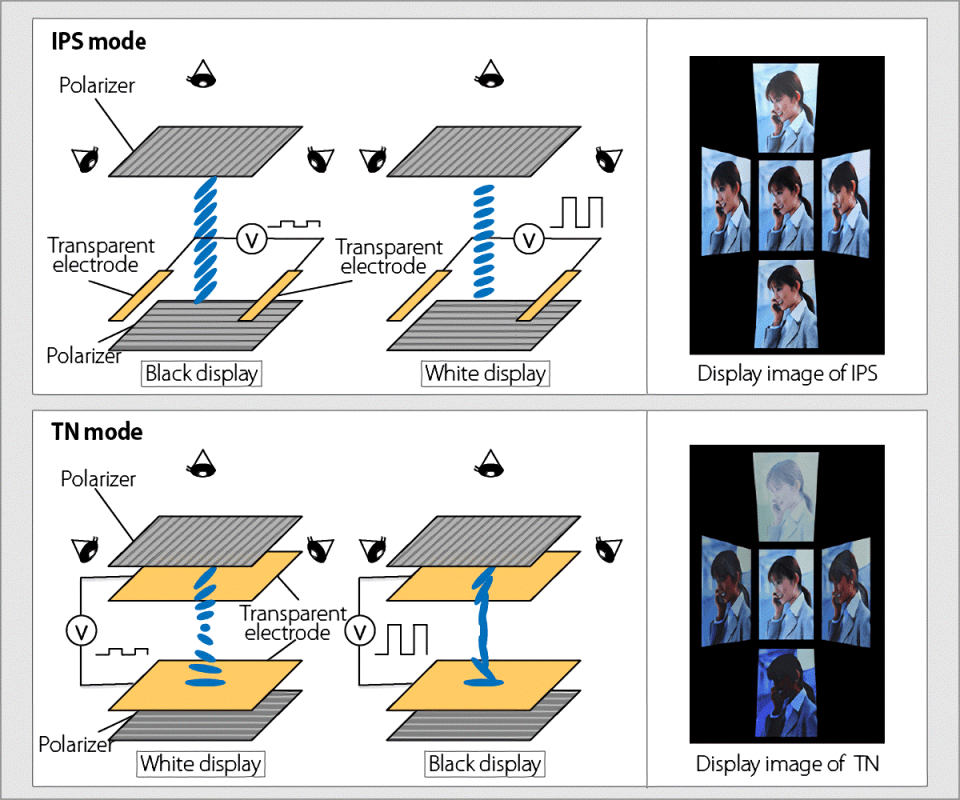IPS vs VA panels in TVs: Which one is better?
When buying a TV with LED technology, we can find different screen technologies. Choosing a TV with one type of screen or another is a factor that will influence the image quality significantly. Mainly two types of panels are manufactured: IPS and VA panels. As we will see now, depending on the use you are going to give to your TV, you may be more interested in a TV with VA panel or IPS panel.
Next, we are going to explain the differences between IPS panels and VA panels. In this way, we hope to help you choose the best TV for your particular use.
IPS Panels
We start by looking at IPS panel technology and how it works, as well as its advantages and disadvantages.
First of all, comment that the name IPS comes from the fact that the liquid crystals of the panel are aligned horizontally (In-Plane Switching). These crystals are parallel to the glass substrates allowing the orientation to be changed by rotating the liquid crystal molecules in the same plane.
IPS Panel Performance – IPS vs VA Panel Comparison
This is the technical explanation, but the interesting thing is to know, what performance this type of panel is going to give us and what pros and cons it offers.
An IPS panel offers as a great advantage, wide viewing angles. This means that even if the TV is viewed from a side angle, contrast and color are maintained.
Some IPS panels offer lossless viewing angles up to 178°. Thanks to this, a TV with an IPS panel can be viewed correctly from the sides. The good thing about this is that color saturation and contrast will remain almost lossless when viewed from the side.
So, you may be interested in buying an IPS panel TV if you are going to watch it from different points or if you are several in the family and there are some of you who watch the TV from a more foreshortened position.
Their response time is usually somewhat lower than those offered by VA panels. The time it takes for the pixels to change is somewhat less and they can deliver moving images with a little more clarity.
Pixel Matrix IPS panel – IPS vs VA Panel
As weaknesses, their contrast is usually quite low. The contrast values of any IPS panel are always poorer than those offered by a VA panel. In this type of panels, the black level achieved is very low and are usually dark grays instead of blacks.
The black level, however, can be improved in Full Array TVs with Local Dimming and in Mini LED models. The models with this system use more LED bulbs and with the possibility of adjusting the illumination by zones, achieving better black values. The downside is that as a general rule, IPS panels tend to have more light leakage problems than VA panels, although this varies from unit to unit and the type of backlight used.
Also the transition between dark tones is very poor and causes a lot of information to be lost in the shadow areas. When there are dark tones, all those tones tend to look like one tone and often the transitions between those different tones are not distinguishable.
When there are dark tones, all those tones tend to look like one tone and often the transitions between those different tones are not distinguishable.
Generally, they are not the best choice for movie buffs as a lot of information is lost in dark scenes. Compared to a VA panel, this problem is noticeable.
It is also common, that they have more reflections compared to VA, although this depends on each model and if it includes any added filter to reduce reflections.
IPS panels are widely used in monitors, thanks to what we have said about their better response time and better color reproduction and are especially recommended for photo editing.
The main manufacturer of IPS panels is LG. Some Sony and Panasonic models carry IPS panels, and these are mostly manufactured by LG Display. Although recently LG announced that it was cutting back on LCD panel manufacturing.
Within IPS panels there are different variants with different names but which are based on the same concept and obtain very similar performance. The best known are the PLS and ADS panels, which are mounted in some current Samsung TVs.
The best known are the PLS and ADS panels, which are mounted in some current Samsung TVs.
ADS panel pixel structure
In this case, this type of panels are manufactured by other companies such as BOE, Innolux or AU Optronics.
VA Panels
Having seen how IPS panels work, it is now time to see what VA panels consist of.
Unlike an IPS panel, a VA type panel has an alignment of liquid crystals in a vertical plane to the glass substrate and which tilt when a voltage is applied to let light through.
VA panel performance – VA vs. IPS panel
VA panels achieve much higher contrasts than IPS panels. Their major advantage is the reproduction of deep blacks and better detail in shadow areas, so that not as much information is lost as in IPS type displays.
Pixel array VA panel
The contrast levels of a VA panel, can be up to 300% higher than that of an IPS panel. The black tones it achieves are always much deeper. This is very noticeable in dark scenes in movies. Therefore, it is the best choice for moviegoers.
Therefore, it is the best choice for moviegoers.
(The following images are for guidance only, as it depends on each particular model and the type of backlighting used, whether Full Array, Edge LED or Direct LED).
IPS panel: grayish blacks and loss of detail in shadowsVA panel: Deeper blacks and better shadow definition
Its weak point is the viewing angles. They usually offer reduced viewing angles, and from 35-40º there is a degradation in contrast and color.
However, new versions of these panels are being produced and the angles are improving, especially in the high end, and in some cases are equal to the angles offered by IPS.
Some examples are the top of the range series Samsung Neo QLED which feature the Ultra Viewing Angle filter or the X95K and Sony’s Z9K series with the X-Wide Angle filter. These series look very good from the side and in this respect have a viewing angle similar to that of OLED TVs.
The main manufacturer of VA panels was Samsung and their own TVs mainly mounted panels manufactured by themselves. However, like LG, they have greatly reduced production and it is now very common for them to carry panels from other manufacturers such as BOE, AUO, etc.
The other manufacturers such as Sony and Panasonic have long since stopped making panels and carry panels made by companies such as Chi Mei, Sharp or AUO. In any case, the fact that a brand does not produce its own panels, does not mean in any case, less image quality.
Summary advantages and disadvantages IPS and VA panels
We leave you with a summary of the advantages offered by each type of panel for you to value which is the option that suits you best according to the use you give to the TV.
Viewing angles
Here the winner is IPS panels by offering better viewing from extreme angles. Colors and contrast are best maintained when viewed at angles greater than 35°..
Wider viewing angle on IPS panels.
It is recommended that you choose a TV with IPS screen, if you are going to watch it from an armchair located in a far corner, if you have a TV hanging on the wall and you watch it from very low or very sideways or if you are several in a family and not everyone can see it more or less from the front.
In VA screens, there is usually a loss of contrast quite pronounced from about 35-40 ° looking a more washed out image. Also the colors begin to lose saturation and flatten out, losing detail in the colors and looking more uniform.
IPS panel vs VA panel viewing angle comparison
Anyway, there are some TVs with VA panel, which incorporate a filter that improves the viewing angle. An example is the Samsung’s top-of-the-line QLED models. and the X95K and Z9K from Sony.
In summary, especially in the low and mid ranges IPS panels provide a better side view than VA panels, so they are better if you view them from different points.
Contrast
The winner in this field is VA panels. The contrast is much higher than that offered by IPS panels, which are far inferior in this respect. Blacks tend to be purer on VA panels than on IPS panels.
The difference between IPS and VA panels is usually quite noticeable in this aspect reaching up to 300% in some cases. Therefore, they are always much more recommendable for users who like movies.
In IPS screens also, there is a worse transition in the shadow areas producing a gray spot effect losing more information in that area.
(The following images are only for orientation, since it depends on each specific model and the type of backlight used, whether Full Array, Edge LED or Direct LED).
Dark scene on IPS panel – Contrast IPS panel vs. VA panelDark scene on VA panel – Contrast IPS panel vs. VA panel
This difference in contrast, is mainly noticeable, when the TV is viewed in a dimly lit or totally dark room.
In the contrast variant, the brightness level also comes into play. In this aspect, an IPS or VA panel can reproduce a similar brightness, but having a better black level, the contrast ratio of a VA panel is usually much higher than that provided by an IPS.
Therefore, the best panels for watching movies and series especially in dark or very low light environments are VA panels.
Screen markings and retentions.
It is unusual for burn-in or retentions to occur on LCD displays whether they are IPS or VA type. This problem occurs when an image is left static for a prolonged period of time. However, the risk is higher for IPS type displays.
In any case, the risk is minimal and not as likely as it can happen in OLED TVs, although also in these, the risk is very low today if used at home and not in a store.
IPS vs. VA panel Which is better then?
As we have seen, depending on your intended use, each offers a number of advantages and disadvantages.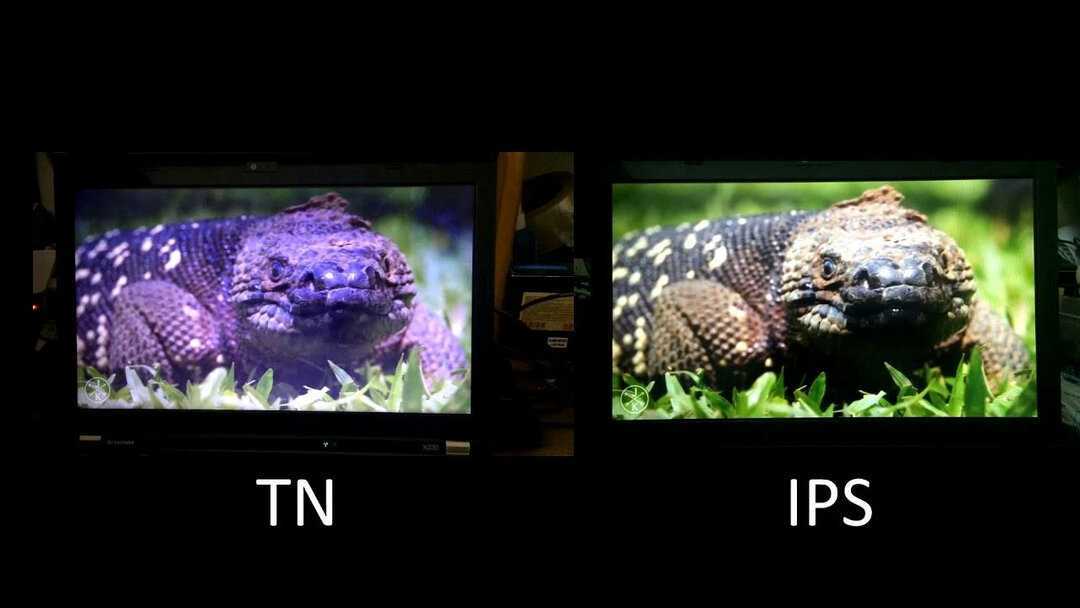
VA panels are more recommended for watching movies and series in dark rooms and in a location that is quite in front of the TV. They give us the highest contrast values and allow us to see better details in the dark parts of the image. Also, although it depends on each specific model, they usually have less reflections.
IPS panels on the other hand, are the best option, if the location from where you sit is not fully frontal to the TV and you usually watch it in a brightly lit room. Colors and contrast are maintained with less variation when viewed from the sides.
Summary of advantages and disadvantages IPS panels
Advantages IPS panels
- Good viewing angle
- Better color reproduction
- Best response time
Disadvantages IPS panels
- Low contrast
- They tend to have more light leakage
- Loss of detail in dark parts.
Summary of advantages and disadvantages VA panels
Advantages VA panels
- High contrast
- There is usually less light leakage
- Better shadow detail
Disadvantages VA panels
- Worst viewing angle
List with some examples of 2019-2021 models with IPS and VA LED panels.

Here we leave you a list of TVs from the most important brands with IPS panel and VA panel organized by manufacturer and year of manufacture.
Samsung
| 2022 models | 2021 models |
|---|---|
| QN900B, QN800B, QN700B, QN95B, QN90B: VA | QN900A, QN800A, QN750A, QN95A, QN90A: VA |
| QN85A: ADS-IPS (VA at 85″). | QN85A: ADS-IPS (VA at 85″). |
| Q80B, Q70B, Q60B: VA | Q80A, Q70A, Q60A: VA (IPS in 65Q60A). |
| BU8500, BU8000: VA | AU9005, AU8005, AU7175: VA |
LG
| 2022 models | 2021 models |
|---|---|
| QNED96, QNED91, QNED86, QNED80: VA or IPS depending on inch | All the range mounts IPS panel except in 50 and 70 inches which is VA.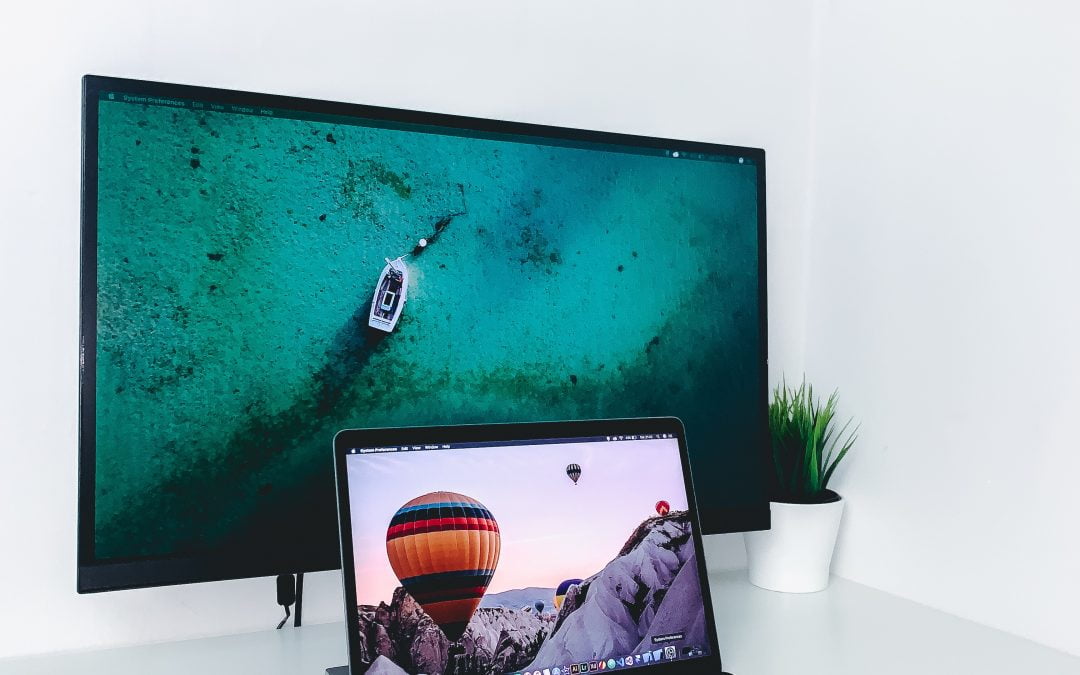 |
| Nano76, Nano75: IPS (VA at 43″ and 50″). | |
| UQ90, UQ80: VA or IPS depending on inch |
Sony
| 2022 models | 2021 models |
|---|---|
| Z9K: VA | ZH9:VA |
| X95K, X90K, X85K, X73K: VA | X95J, X90J, X85J: VA |
| X80K and X81K: IPS (VA at 50″) | X80J and X81J: IPS (VA at 50″) |
Panasonic
| 2022 models | 2021 models |
|---|---|
| LX950, LX900: IPS | To be confirmed |
| LX650: VA |
Philips
| 2022 models | 2021 models |
|---|---|
| PML9637: VA PML9507: VA PUS8507: VA PUS7607: VA PFL5507: VA |
PML9636: VA PML9506: VA PUS8506: VA (IPS at 65″) PUS7906: VA PUS7406: VA PFL5756: IPS |
Hisense
| 2022 models | 2021 models |
|---|---|
| To be confirmed | U9GQ: IPS U8GQ: IPS A7GQ: IPS (VA at 43″ and 50). 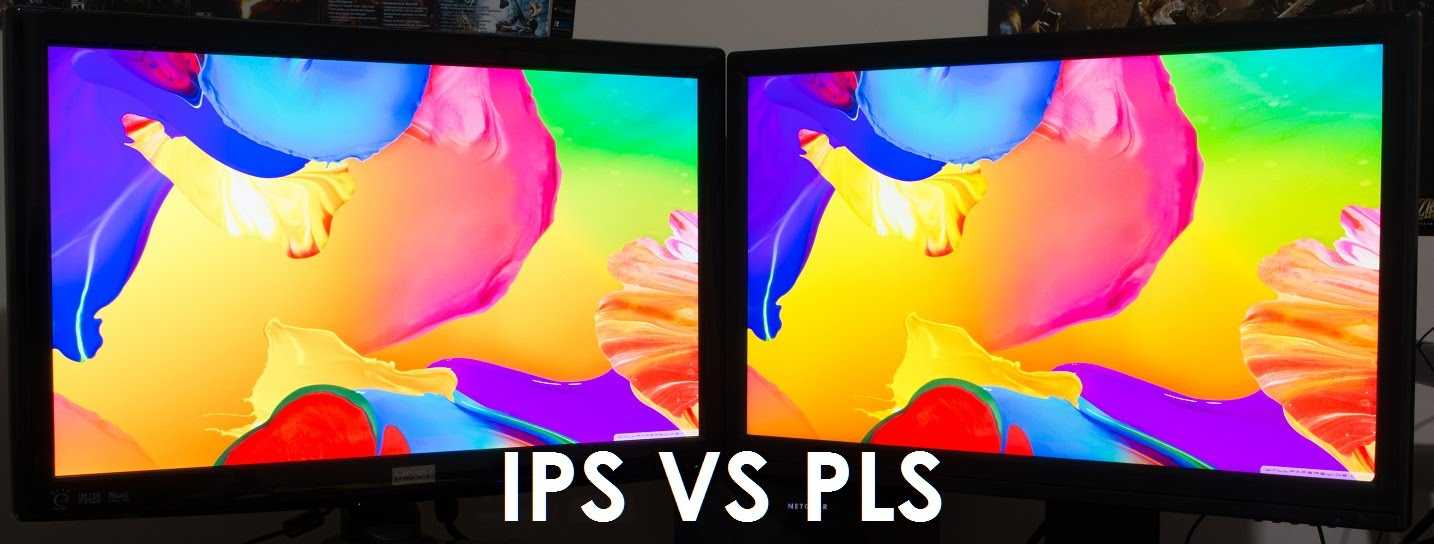 E76GQ: IPS (VA at 43″ and 50). A6G: IPS (VA at 43″, 50″ and 58″). |
As you can see, each type of panel has its advantages and disadvantages. With this comparison, hopefully the differences between IPS and VA panels are clear to you. Moreover, these panels are not only found in televisions, but are also manufactured for monitors and cell phones.
Recommendations of the best TVs with VA panel
TCL 55-inch 6-Series 4K UHD Dolby Vision HDR
QLED Roku Smart TV
SEE PRICE
Sony 65 Inch 4K Ultra HD TV X90K Series
BRAVIA XR Full Array LEDDolby Vision HDR
SEE PRICE
Samsung 55-Inch Class Neo QLED 4K QN95B Series
Mini LED Quantum HDR 32x Smart TV 2022
SEE PRICE
Sony 65 Inch 4K Ultra HD TV X95K Series
BRAVIA XR Mini LED, Google TV, Dolby Vision
SEE PRICE
SAMSUNG 85-Inch Class Neo QLED 8K QN900B Series
Mini LED Quantum HDR 64x, Infinity Screen
SEE PRICE
TCL 85-inch Class 4K UHD Dolby Vision HDR
QLED Roku Smart TV
SEE PRICE
Recommendations of the best TVs with IPS panel
Sony 43 Inch 4K Ultra HD TV X80K Series
Smart Google TV with Dolby Vision
SEE PRICE
LG 55-Inch Class QNED80 Series Alexa Built-in
4K Smart TV, 120Hz Refresh Rate, AI-Powered 4K
SEE PRICE
Samsung 55-Inch Class Neo QLED 4K QN85B Series
Mini LED Quantum HDR 24x Smart TV 2022
SEE PRICE
LG 75-Inch Class NANO75 Series Alexa Built-in 4K Smart TV
60Hz Refresh Rate, AI-Powered 4K, Cloud Gaming
SEE PRICE
Frequently Asked Questions
What type of panel is best for dark viewing?
For viewing in dark or very dimly lit rooms, the best choice is a TV that mounts VA screen, as it will provide better blacks as well as less blooming and light leakage.
If I view the TV from the side, what type of screen is best?
If in your case you are going to be viewing the TV from a fairly foreshortened angle, IPS panels are going to offer you a better angle than VA panels. The colors will maintain better saturation as well as the contrast will be maintained, making the picture look less washed out.
Which is better, an IPS panel or a VA panel?
As we have seen, it depends on each situation, but generally in the absence of assessing other important aspects such as the image processor, refresh rate, etc., we recommend a TV with VA panel. They are the most recommended for watching movies and series due to their better contrast and detail in the dark parts.
Is an LED TV or an OLED TV better?
It depends on the models we compare, but usually the highest picture quality today is going to be provided by a TV with OLED technology, thanks to being a self-emissive technology. This means that each pixel is the light source and can be switched on and off independently, giving a pure black, which LED TVs cannot achieve.
This means that each pixel is the light source and can be switched on and off independently, giving a pure black, which LED TVs cannot achieve.
Recently, TVs with Mini LED technology have been launched, which still use an LCD panel with backlighting by LED bulbs, but now the size of these is much smaller. In this way, they can have many more bulbs, so that the backlighting is more accurate, improving blacks and reaching a higher peak brightness. In this last aspect of brightness, Mini LED TVs are superior to OLED models.
If you want more information about these technologies you can visit the following article where we give you all the details: Mini LED vs OLED – Which is better? Comparison and differences
IPS Vs VA Panel — What’s The Difference?
In Plane Switching (IPS) and Vertical Alignment (VA) are the two best middle-ground LCD display technologies available today. So, if you’re looking to buy a new monitor or a TV, you might be wondering whether to get an IPS or a VA panel for your display.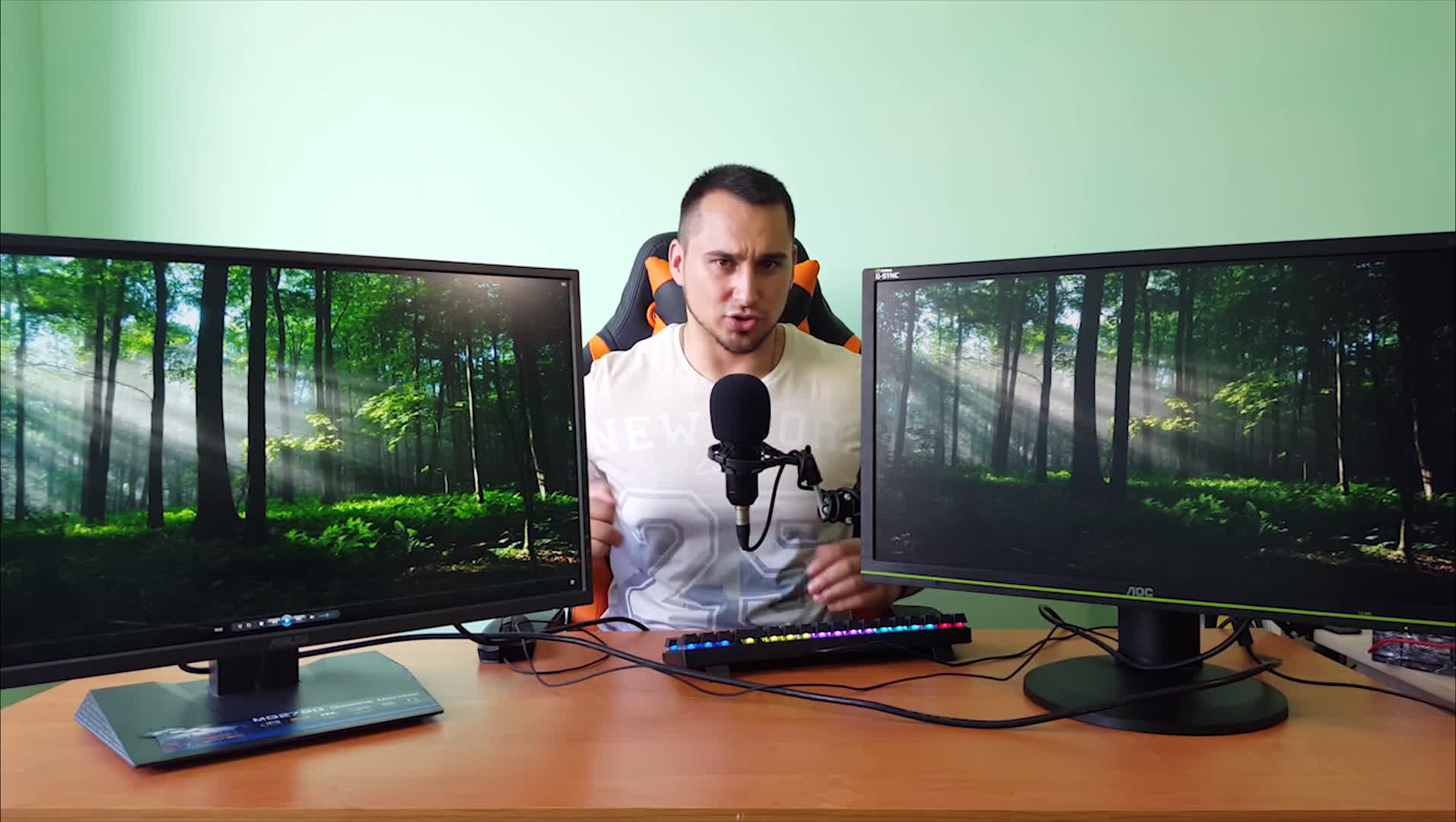
When it comes to their display, users generally focus on parameters such as color reproduction, contrast ratio, viewing angles, refresh rates, response time, ghosting, etc depending upon their use case. You might prefer a stronger performance in one area while you might not care much for another. The type of your workload and budget might come into consideration.
So what is your use case, and which panel best suits your needs? We will dive into details about all these things in the article below.
Table of Contents
What is an LCD Display Technology
A Liquid Crystal Display (LCD) is a flat panel display that uses light modulation via liquid crystals, in conjunction with polarizers and a backlight to display an image on the screen.
The backlight produces light, which gets polarized by the filters. Liquid crystals in certain orientation allow the polarized lights to pass through them while in a different orientation, the passage of light is blocked.
The Liquid Crystal layer determines the intensity and the color of the light that is let through to produce the desired image.
A matrix of liquid crystals, polarizers, and backlights can be arranged to produce tiny dots on a screen, which are effectively pixels.
There are different types of LCD display technologies available, viz., Twisted Nematic (TN), In Plane Switching (IPS), and Vertical Alignment (VA). Their variation comes from the initial arrangement of liquid crystals and their behavior when a voltage is applied.
What is an IPS Panel?
Source: AOC
An IPS panel has liquid crystals sandwiched between two glass surfaces. The crystals are arranged in a plane parallel to the display (in-plane). Applying an electric field to the crystals rotates them in-plane, allowing for passage of polarized light, which creates a display on the display surface (screen).
Talking about panel performance, IPS panels do well in Adobe RGB and Rec.2020 color spaces. However, their lower performance in contrast ratio can be undesirable when dealing with contrast heavy works. They are able to attain sufficient brightness to perform under daylight.
Among every available display technologies today, IPS panels currently have the highest refresh rate. However, IPS panels generally are affected by IPS bleed, which is an undesirable quality in a display panel.
Pros:
- Good color reproduction
- Excellent viewing angles.
- Good visibility under sunlight.
- Better refresh rate.
Cons:
- Not great contrast ratio when compared to VA panels.
- Are susceptible to IPS bleed.
What is a VA Panel
Source: Trustedmonitors
A VA panel has its liquid crystals suspended in a vertical orientation to the plane of display (glass substrate). These are arranged to not allow polarized light to pass through when no electric field is present. But when a voltage is applied, the crystals shift to a tilted position, allowing light to pass through, which can then hit the screen and produce a display.
VA panels have a decent coverage of sRGB and DCI-P3 color gamuts, which is suitable for video playback and playing video games.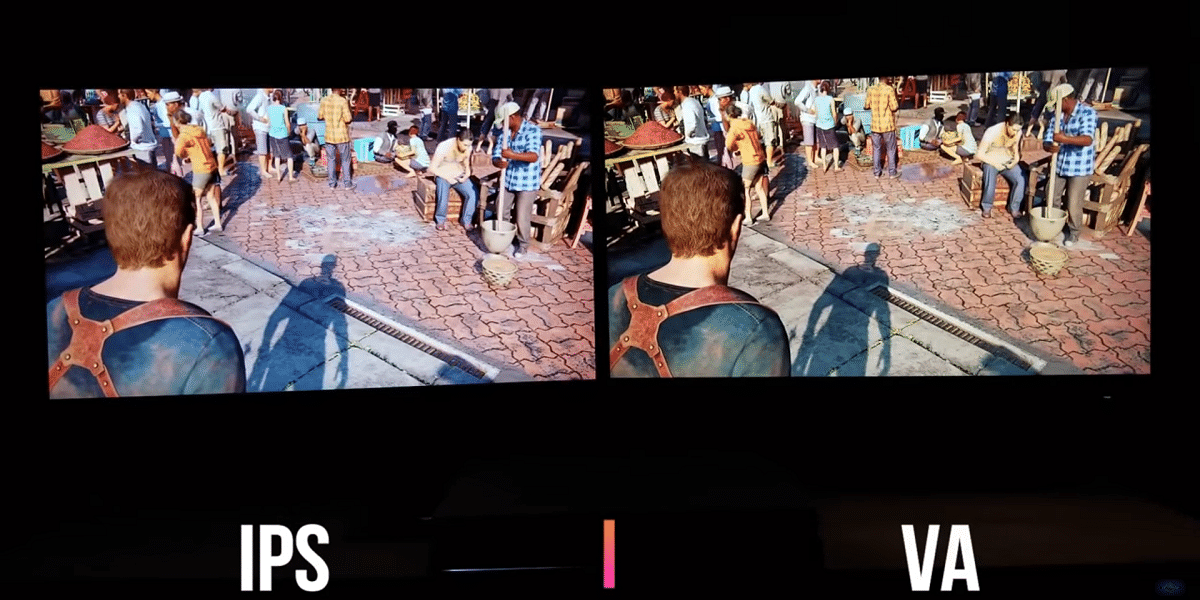 In addition, most VA panels available in the market today are curved screens, which can help with the experience of immersion. VA panels are also able to achieve the highest contrast ratio for an LCD panel, which is a desirable feature for enjoying HDR contents.
In addition, most VA panels available in the market today are curved screens, which can help with the experience of immersion. VA panels are also able to achieve the highest contrast ratio for an LCD panel, which is a desirable feature for enjoying HDR contents.
Backlight bleed in VA panels is more manageable, and they also can perform decently under daylight.
Pros:
- Good contrast ratio.
- Better back light bleed management.
- Decent performance under sunlight.
Cons:
- Worse color reproduction than an IPS panel
- Worse refresh rate than an IPS panel.
- Curved VA panels have reduced viewing angle.
Comparing IPS and VA Panels
Regardless of the similarities or differences in the technology implemented to produce the desired result in IPS and VA panels, as end users, we generally tend to focus on the performance of these panels instead.
The metrics that we can use to tangibly judge the strength and weakness of a particular type of panel, when it comes to display technology, are:
- Contrast ratio.

- Color reproduction.
- Brightness.
- Viewing angle.
- Refresh rate.
- Average response time.
- Motion performance.
- Backlight bleeds and IPS/VA Glow.
Now let us take a closer look at IPS vs VA performances for each of the aforementioned factors.
Contrast Ratio
Contrast between IPS VS VA
Contrast ratio is a term used to denote the ratio of illuminance of the brightest area of a display to the darkest one. A display with a high contrast ratio can give you the deepest black while if your display’s contrast ratio is not good, you will end up with a gray-looking black.
Hence, a display with a higher contrast ratio is always preferable.
In this metric of comparison, the VA panel comes out on top. VA panels these days are usually capable of contrast ratio in the range of 2000:1 – 3000:1. IPS panels, on the other hand, usually hover around the 1000:1 mark, with the best IPS panels able to perform in a 1200:1 vicinity.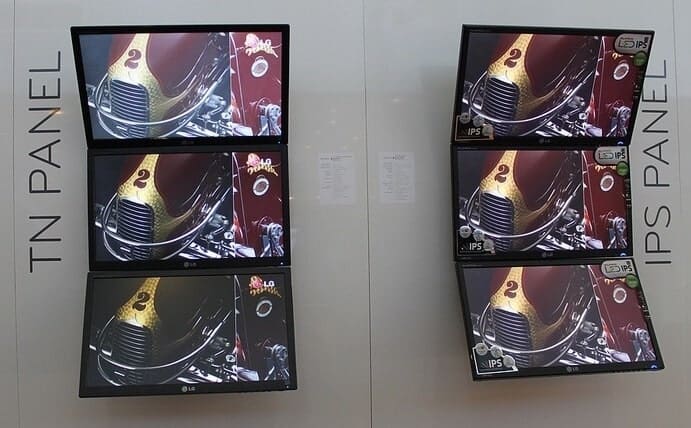
With a 2-3 times better performance, VA panels are the clear winner here.
Color Reproduction
Difference in color reproduction
Display technologies employ certain color gamuts for color reproduction. A display that is able to cover a wider range of color gamut is better able to reproduce the colors accurately.
Traditionally, displays have used sRGB gamut for color reproduction. However, newer displays adopt wider color gamuts such as Adobe RGB, DCI-P3, and Rec.2020.
Typically, VA panels cover 85-90% DCI-P3, less than 85% Adobe RGB, and 60% Rec.2020 color coverage. In contrast, IPS panels are able to cover 97% DCI, 99% Adobe RGB, and 80% Rec.2020.
Thus, in color reproduction, IPS panels come out ahead.
Brightness
Difference in brightness
Fun fact: screen brightness is measured in candles worth of luminance. That’s right. A display emits light worth several candles of light per square meter, and that is how we measure how bright a screen is. This unit is commonly called “nits” in display technology.
This unit is commonly called “nits” in display technology.
If you have a display with a higher nit number, the more visible it will be in daylight. Screens with lower nits will make you squint for visibility in bright light conditions, which is not ideal.
Exciting as the definition of brightness was, when it comes to comparing IPS vs VA displays, the result currently is basically tied. A display with consistent brightness of 300 nits is preferred for daylight viewing, and in this respect, both these displays obtain passable scores.
Of course, the peak brightness value for a given display might vary depending upon the manufacturer, but that is certainly not something that is limited by technology.
The verdict, thus in this case, is a tie.
Viewing Angle
A panel with good viewing angles can retain good visual performance even when viewed from the sides. If you look at the panel from the side and it starts to look as if you are viewing a negative of a film, or the color looks weird, then the display has a weak viewing angle.
Both IPS and VA panels are capable of around 178 degrees of viewing angle. Hence, it might look like they are tied in this aspect.
However, the vast majority of IPS panels are flat screens while VA panels are curved. A curvature of the screen naturally provides a reduced viewing angle when compared to a flat screen.
Depending upon your use case, you might want one over the other.
Refresh Rate
Source: BenQ
When you are watching a movie, it looks like you are watching a fluid motion. However, in reality, you are watching a series of pictures in quick succession. How many times pictures are drawn into the screen per second is known as its refresh rate.
A higher refresh rate screen appears more fluid in comparison to one with a lower refresh rate. Typically, when you consume a media where you are only passively involved, such as watching a movie or a documentary, you will not need a high refresh rate display.
However, when you are actively involved in the activity that is being presented on the screen, for example, when you are playing a video game, then a slight difference in refresh rate can be noticeable. This is especially true in fast-paced first-person shooters like CS:GO.
This is especially true in fast-paced first-person shooters like CS:GO.
The best IPS displays of today are capable of 360 Hz refresh rate in 1080p resolution. The best VA panels, on the other hand, are capable of 240 Hz in 1440 resolution.
Hence, if you are after a display that is capable of the highest refresh rate available in the market today, you need an IPS panel.
Average Response Time
Source: BenQ
This is the measure of time taken by a pixel to change. A slow changing pixel leaves behind ghosting, and artifacting, even if the display overall has a high refresh rate. Thus, you want the lowest possible average response time in your display.
The most commonly utilized metric to measure a screen’s response time is gray-to-gray (g2g) average. This is measured in milliseconds (ms).
Although both high-end IPS and high-end VA panels today claim a 1ms gtg response time, typical panels are found to have a gtg response time in the vicinity of 4 ms. This is true of both IPS and VA panels.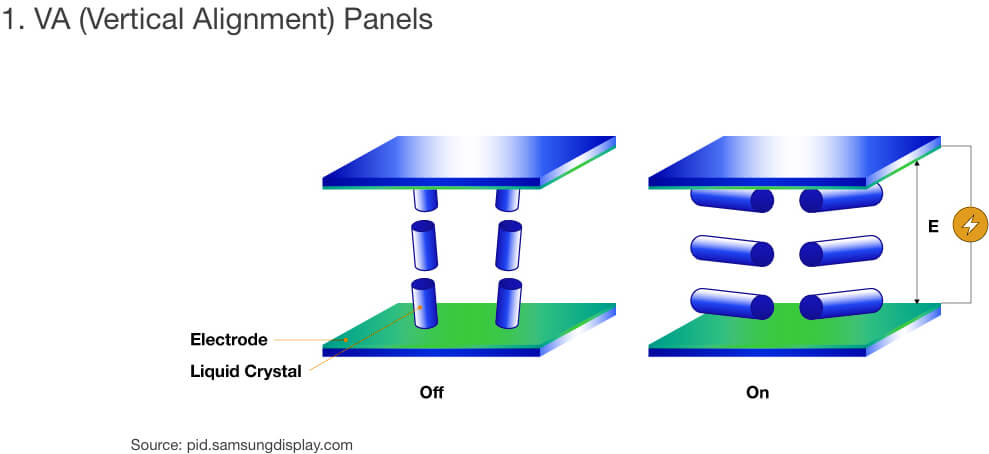
Motion Performance
In contrast to Cathode Ray Tube (CRT) displays that draw images by scanning pixels, LCD displays hold a pixel during the entirety of refresh time. When you track a moving object on the screen, your eyes are continuously moving. This can create a perceived motion blur.
To solve or mitigate this issue, display manufacturers implement backlight strobing or black frame insertion.
Inserting of intermediate black frames between normal frames is found to reduce the effect of motion blur (black frame insertion).
Another method to combat motion blur is to use a very short strobe to illuminate the display per refresh, achieving a result similar to phosphorus illumination and decay cycle in a CRT display (backlight strobing). The shorter the strobing period, the better the motion quality.
Generally, you can get a good result in both types of panels depending upon the implementation of this technology.
Backlight Bleeds and IPS/VA Glow
Some of the backlights used in LCD may leak out around the bezels because they are not entirely blocked in those areas. This is known as backlight bleeding.
This is known as backlight bleeding.
Again, the technology itself has no bearing on backlight bleeds. Some backlight bleed is expected in all LCD monitors, this is a limitation of the technology.
However, a similar phenomenon can occur at the corner of panels, called the IPS or VA glow. This glow can be obvious if you are viewing a content in a dark room with high brightness. This is commonly attributed to defects in the manufacturing process panels.
When the two are compared, IPS glow is generally acceptable as a more serious offender than the VA glow
The Verdict: IPS or VA Panel
From the detailed comparison that we performed of IPS vs VA panels above, we can see that IPS panels are typically well-balanced in most aspects and can perform well as an all-rounder
IPS panels perform well in Adobe RGB and Rec.2020 color spaces, and hence are suitable for color-critical workloads such as video and photo editing. However, their lower performance in contrast ratio can be undesirable when dealing with contrast-heavy work.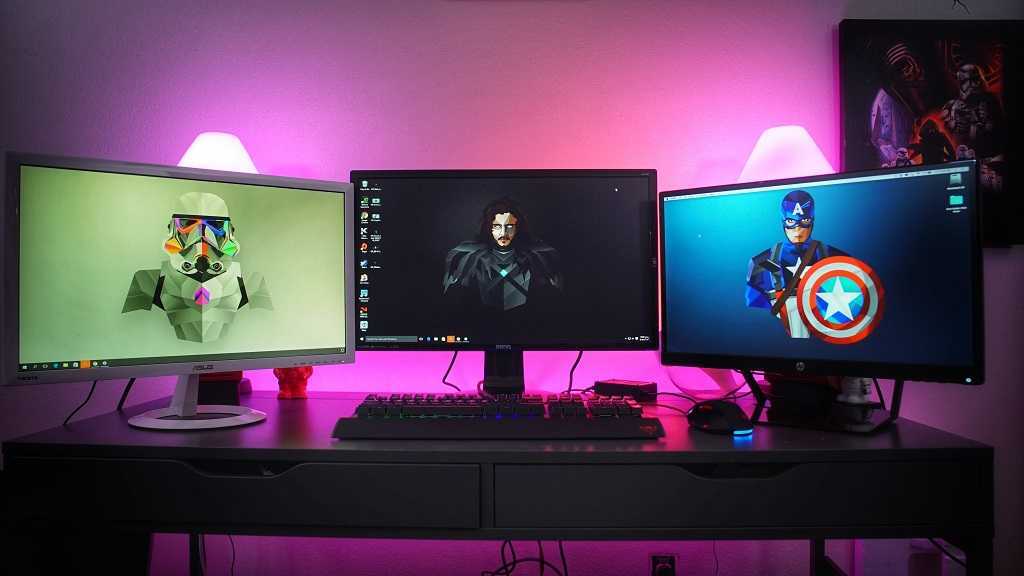
IPS panels are also suitable for gamers who play ultra fast-paced FPS games and consistently hit a frame rate of 300+ frames per second.
VA panels have decent coverage of sRGB and DCI-P3 color gamuts, and with such, VA panels are better suitable for video playback and playing video games. Curved screens in a VA display can also help with the experience of immersion. VA panels are also able to achieve a 2-3 times higher contrast ratio, making them suitable for viewing HDR contents.
VA panels are better suitable for gamers and folks who sit close to their desk immersed in their daily workloads.
Differences Between IPS and VA Panels
So here are the few critical differences between an IPS and a VA panel:
| IPS Panel | VA Panel | |
| Color Reproduction | Better color reproduction.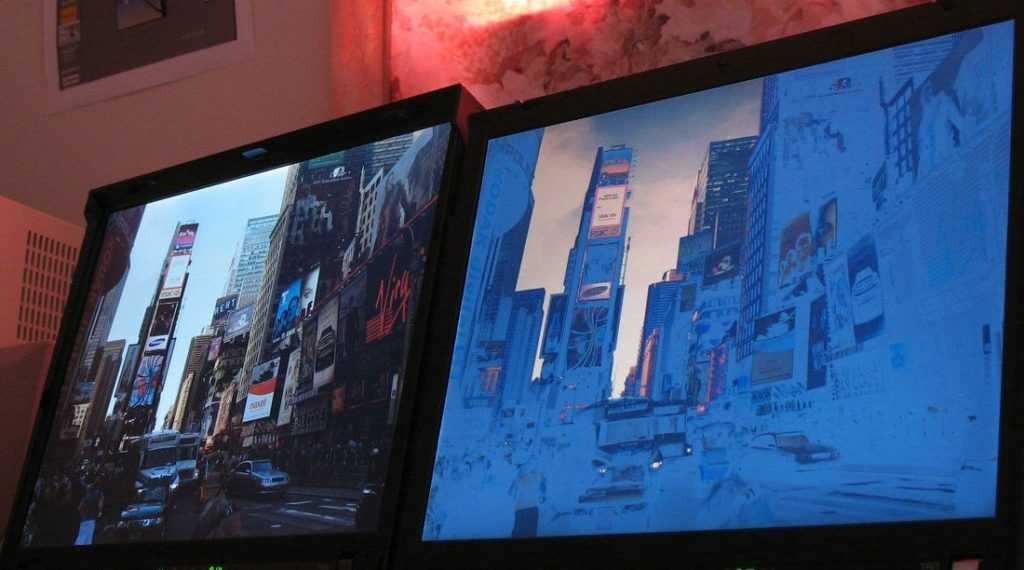 (97% DCI, 99% Adobe RGB, and 80% Rec.2020) (97% DCI, 99% Adobe RGB, and 80% Rec.2020) |
Worse color reproduction. (85-90% DCI-P3, less than 85% Adobe RGB, and 60% Rec.2020) |
| Contrast Ratio | Worse contrast ratio. (On average, 1000:1) | Better contrast ratio. (On average, 2000:1 – 3000:1) |
| Refresh Rate | Better refresh rate. (up to 1080p @ 360 Hz) | Worse refresh rate. (up to 1440p @ 240 Hz) |
| Viewing Angle | Better viewing angles. (up to 178 degrees) | Curved VA panels have reduced viewing angle. |
| Backlight Bleed | Undesirable “IPS bleed.” | “VA bleed” is not as bad as “IPS bleed.” |
Matrix VA or IPS — which is better?
- Material Information
- Igor Rybachuk
Questions and Answers
To answer the question which matrix is better than VA or IPS, you need to clearly understand your scenarios for using the TV.
The same type of matrix will look better in some conditions and noticeably worse in other conditions.
These matrices have a different pixel structure, due to which they have strengths and weaknesses. nine0011
For example, a VA matrix has a significantly higher native contrast ratio of 2000-6000:1. Which gives a more three-dimensional image, especially in dark scenes. And deeper blacks, which is important for the perception of films. The negative side of the VA matrix is weak viewing angles horizontally and, especially, vertically. Horizontally, the shades will be distorted, vertically, the detail in the shadows. General tendency to lighten shades.
IPS matrix has wide viewing angles, the pixels are oriented in such a way that the light is scattered to the sides. But because of this, the contrast suffers (usually 700-1300:1) and the black level is only sufficient for viewing in a well-lit room. In a darkened room, the sensitivity of the eyes to the perception of details in the shadows increases and “black” becomes gray. nine0011
nine0011
Thus, we can distinguish several sub-points for the optimal use of such matrices in TVs.
Matrix VA or IPS — which is better for a TV?
If the TV is primarily for cinema. Viewing in the dark or with weak light, or, conversely, a very bright room. At the same time, movies will be watched directly in front of the screen — the best option would be a TV with a VA matrix (if we talk only about LCD technology)
If the use of TV is more versatile, often with lighting, but not too bright, IPS will be more interesting due to wider viewing angles. Such a TV does not have to be optimally positioned in height in front of the viewer — it is less demanding on the place where it will be located.
VA or IPS matrix — which is better for a monitor?
If you use TV as a monitor, you need to clearly place the accents — whether the TV will be used to work with graphics and video, or is it just a large universal screen. nine0011
nine0011
In the first case, clearly, IPS is needed. Moreover, it is “correct” when there are three color subpixels in each pixel.
IPS RGBW example:
In this case, the brightness on white, other things being equal, the TV is higher, but the color gamut is lower (one of the color subpixels is replaced by white) and, most importantly, because pixels are organized not in columns, but in honeycombs; it will not be possible to obtain even lines one pixel wide. IPS RGBW is used in budget 4k LG TVs. However, it can also be found in other brands. nine0011
In the second case -VA will be more interesting, because higher contrast, black depth, and viewing angles are often not important.
Matrix VA or IPS — which is better for gaming?
In terms of pixel response, you need to look at specific models. In TVs, as a rule, budget IPS have a lower response, shorter cables.
But the lack of a good anti-reflective filter, weak contrast and spotting of the Direct backlight are not encouraging. Again, there are exceptions everywhere.
Again, there are exceptions everywhere.
nine0010 In terms of the image as a whole — if you play with lighting, before that there were TN or IPS matrices in use — you can take IPS.
If you play with a weak light in the dark or without it at all — ideally OLED, or at least a VA matrix. Dark scenes on such panels will look better.
Which matrix is better — TN or IPS?
TN matrix structure:
At the moment, such matrices in TV are used very rarely and in small diagonals. There is only one advantage of such a matrix — its low cost. In modern realities, these matrices are best avoided. nine0011
In this article, we did not discuss anti-glare filters, or pixel response, or backlight types, or how it works in terms of flicker, etc. — all this can be found in more detail on our forum
LCD Displays: IPS, VA or TN Matrix — Breakdown
We stare at screens every day. All of them seem to consist of the same color pixels, but why, then, on different displays, different image quality. What does it depend on?
What does it depend on?
Let’s look at the TV screen under a microscope. We will see the structure of colored pixels. This is the whole secret! Today we understand: what types of LCD or LCD matrices exist, how they are arranged, what features and bonuses they have. And which one is better to choose for your TV at home! And why does the TV need a powerful processor
Spoiler: This will be a Philips TV, but don’t worry, the material is primarily about technology.
How LCDs work
We know that an image on a TV screen is made up of pixels. But what are the pixels themselves made of? It is very interesting. Look!
Looking at the pixel from the front, we see 3 colored sub-pixels: red, green and blue. They are really just color filters and they don’t glow themselves, they only color the light. Behind the pixel is the backlight. It illuminates all pixels evenly. At least a good backlight does it evenly. nine0011
Behind the pixel is the backlight. It illuminates all pixels evenly. At least a good backlight does it evenly. nine0011
But if red, green and blue subpixels are illuminated equally. The colors are mixed in the same proportion and we get just white. And we need millions of different shades. How to get them?
First, you need to learn how to completely block the light in each subpixel. How do you think this is done? With some kind of curtain that goes up and down? No, much cooler!
Polarizing filters come into play. There are two of them at once in a pixel, they stand one after another. First comes the vertical filter, and then the horizontal one. Passing through the first filter, the light seems to be flattened in the vertical direction and becomes polarized in one plane. nine0011
And vertically polarized light can no longer pass through the horizontal filter! Profit! We blocked the backlight. But how do you unlock it now?
This is exactly what a layer with liquid crystals is needed for, which gave the name to the whole technology. It is located in the very center of the pixel, like in a sandwich: between two polarizing filters. Under the influence of the current, the crystals turn and turn the light with them. And help him pass in the right amount. nine0011
It is located in the very center of the pixel, like in a sandwich: between two polarizing filters. Under the influence of the current, the crystals turn and turn the light with them. And help him pass in the right amount. nine0011
That is, the main task of liquid crystals is to control the intensity of light. All LCD matrices work according to this principle, but there are a lot of implementations of it. Hence the different types of matrices: IPS, TN and VA.
TN Matrix
The cheapest matrices are TN. In them, liquid crystals are twisted into a spiral that conducts light from a vertical to a horizontal polarizing filter. Therefore, they are called Twisted Nematic, that is, a twisted nematic crystal.
Such crystals can work in only two states:
- The twisted state is when 100% of the light passes through
- Chaotic — when light does not pass.
Accordingly, such matrices are capable of transmitting only a very limited number of colors. Only 6 bits per channel, i.e. 262 144 shades of color. Counts as 2 to the sixth power for the red, green and blue color channels.
Only 6 bits per channel, i.e. 262 144 shades of color. Counts as 2 to the sixth power for the red, green and blue color channels.
And because of this structure, the screens have terrible viewing angles, especially vertically. Therefore, such matrices are practically not used in televisions. But they are used in gaming monitors — because they are fast. Remember? Only two positions in the crystal (on / off), and therefore fast. nine0011
Moving on. In TVs, matrices of the VA and IPS types are most often found. We are not talking about OLED today, there is a completely different principle of operation, and these mattresses are very expensive. Therefore, today only LCD. Let’s start with IPS.
IPS panels
IPS stands for In-Plane Switching or Planar Switching. In such matrices, the crystals do not twist relative to each other. They are always lined up. By default, they stand in a horizontal position and do not let light through. nine0011
Unlike TN in IPS, you can adjust the angle of rotation of the crystal and change the amount of light transmitted.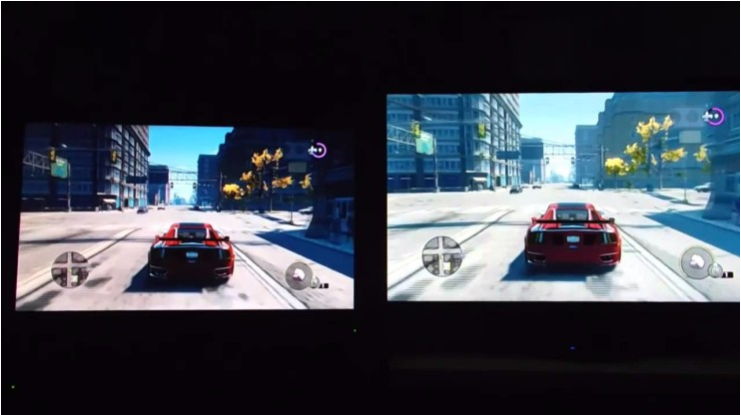 And this means that you can smoothly adjust the brightness of each pixel.
And this means that you can smoothly adjust the brightness of each pixel.
Therefore, such matrices are perfectly calibrated and capable of transmitting up to 10 bits per channel. And this one already has over 1 billion colors — 1.07 billion to be exact.
Also, with this arrangement, the light is better diffused, and this greatly increases the viewing angle. Therefore, IPS-matrices are so respected by professionals working with color. nine0011
As a rule, macro photography of IPS-matrices looks unusual — the pixels are located at an angle to each other and it all looks like arrows. Although there are exceptions in the form of such PLS, which also belong to IPS-like ones.
But IPS also has serious drawbacks. First, the response time. On the first IPS panels, it was 50 ms. Now the record is 4 ms, but this is on the most expensive panels. In TN matrices, for example — only 1 ms.
Then, in such matrices, the distance between the crystals is quite high, which means that they do not block the backlight very effectively.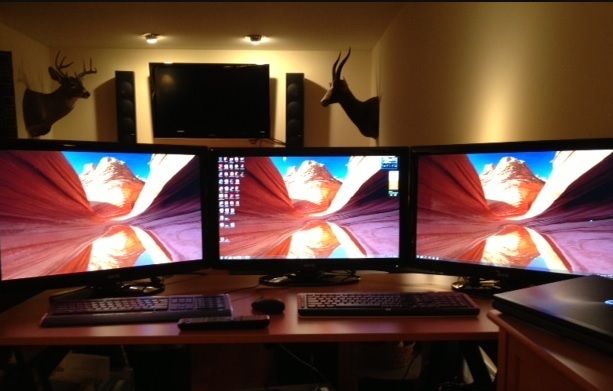 Because of this, flashes appear and in general the level of black light leaves much to be desired. In IPS matrices, a black screen is more of a mysterious bluish haze. nine0011
Because of this, flashes appear and in general the level of black light leaves much to be desired. In IPS matrices, a black screen is more of a mysterious bluish haze. nine0011
And if on the small screens of smartphones, this is not so noticeable. Although … for me it’s very noticeable, thanks — iPhone SE! Then on a large diagonal of 40-50 inches, the problem is already clearly evident. Therefore, for TVs very often the choice falls in favor of a different type of matrices. Namely VA.
VA Dies
VA Dies are vertical when viewed from the side, so VA stands for Vertical Alignment.
But in relation to polarizing filters, liquid crystals are located perpendicular to the filters. In this position, the light passes through them without difficulty. Therefore, in terms of black depth and contrast level, VA matrices are ahead of IPS by 3 or even 5 times. It’s a huge difference, trust me.
But due to the vertical arrangement of the crystals, horizontal viewing angles suffer. If in IPS matrices the viewing angle is somewhere around 178 degrees, in VA this figure is 160.
If in IPS matrices the viewing angle is somewhere around 178 degrees, in VA this figure is 160.
The second disadvantage of VA matrices. Unlike IPS in VA, you cannot smoothly adjust the angle of the crystal, which means you cannot smoothly adjust the brightness of each subpixel. Therefore, the color quality here is not as good as in IPS matrices.
But not everything is so bad. Modern VA matrices are multidomain. This means that there are several liquid crystal blocks in one sub-pixel, which can be controlled separately. This means that each subpixel has several levels of brightness. This is clearly seen from the photographs of VA matrices. nine0011
That’s why modern VAs can easily output 8-bit color. And with the use of FRC technology (Frame rate control), that is, fast blinking of a pixel, it turns out to achieve an almost honest 10-bit image.
Backlight
Now let’s confuse even more.
Image quality is naturally affected not only by the quality of the sensor. The next important point is the backlight.
The next important point is the backlight.
It can be of two types Direct-LED — this is when LED-bulbs are located over the entire area of the back wall. nine0011
And the second type of Edge-LED — when the light comes from one side, usually from below, and the entire screen is illuminated by a diffusing filter.
Naturally Direct-LED allows you to make the backlight more uniform. But most importantly, Direct-LED allows you to implement the Local Dimming function, i.e. local turning off the backlight in dark areas of the frame. Which greatly increases the contrast increases the dynamic range. So it allows you to watch HDR content.
On IPS-matrices, the effect of local dimming is less pronounced, so TVs are more often paired with Edge-LED backlighting. nine0011
But the combination of a good VA-matrix and the right backlight gives an excellent result. So that you understand, if this is not OLED, a VA matrix will usually be installed in a premium TV.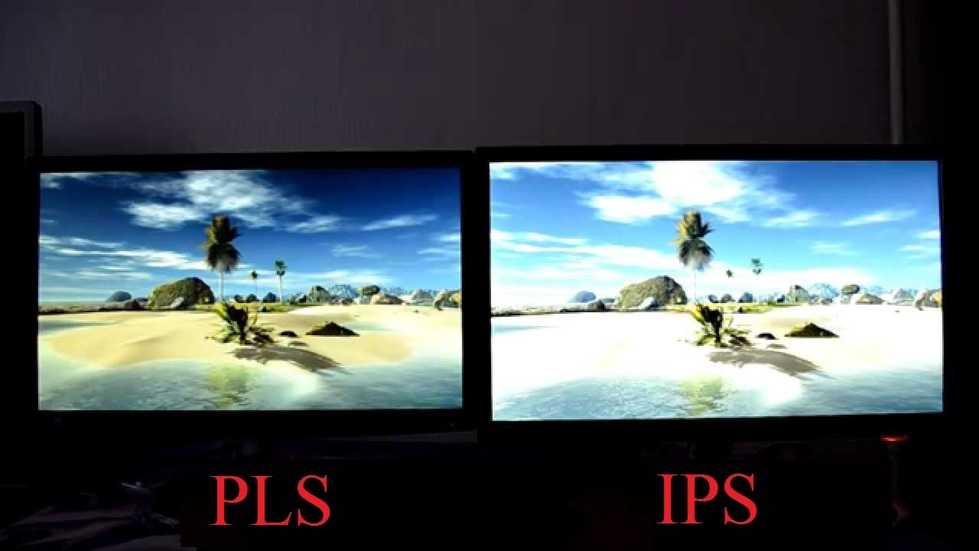
At the same time, VA is an inexpensive technology, so you can also find a good option in the middle price segment.
Philips 55PUS7303
For example, at our request, Philips sent the 55PUS7303. Why did we ask for it? There are three notable things here:
1. In addition to the VA panel and Direct-LED backlight, it uses Micro Dimming Pro technology. It combines 300 physical backlight local dimming zones and 6400 program zones that adjust the brightness and contrast of the image depending on the scene and the lighting in the room.
Therefore, in practice we get a very juicy contrast picture without a visible glow effect from the backlight.
By the way, the Philips P5 processor plays a big role here. He analyzes the image in real time and pumps it in every possible way: upscales, draws frames if necessary, adjusts the contrast, and so on. In TVs, processors really decide. nine0011
2. Since this is Philips, Ambilight technology delivers a buzz. You really have to be careful with this stuff. Buy a Philips once, there may never be a turning back. With Ambilight, any content looks more voluminous, more effective and at night your eyes get tired less!
You really have to be careful with this stuff. Buy a Philips once, there may never be a turning back. With Ambilight, any content looks more voluminous, more effective and at night your eyes get tired less!
3. Our favorite is that the TV runs on Android TV, so if you want to have a choice of what content to watch and like to customize everything for yourself, this is out of the competition.
Distinguishing VA from IPS
Let’s get back to the matrices. When choosing a TV, you should consider one big nuance. The type of matrix in TVs very often varies from batch to batch. And therefore, the store may not know which matrix is specifically in this instance.
This Philips 55PUS7303 TV model is available in three diagonals — 50, 55 and 65 inches. In these sizes, VA matrices are most often installed. But in models with smaller diagonals, IPS comes across more often.
Until you look at a specific instance, you can’t tell for sure which matrix is installed. Therefore, we share with you a few life hacks on how to quickly distinguish VA from IPS. nine0011
Therefore, we share with you a few life hacks on how to quickly distinguish VA from IPS. nine0011
Checking the viewing angles. When viewed from the side, VA matrices pale more than IPS. But this is an unreliable method, because. modern VA matrices don’t fade that much. Therefore, we offer one more.
If you lightly slide your finger over the VA panel, there will be a clear trail of pixels. On IPS, this effect does not happen. Just don’t press too hard — just lightly.
And of course, you can check the black levels. On IPS, the black color is bluish and not black at all. nine0011
And the most hardcore guys can look at the pixel structure if you stock up on a macro lens or a magnifying glass.
Recommendations
The most versatile choice for the home, VA-matrix TVs offer better black levels, backlight uniformity, and overall contrast. These TVs are great for both watching and gaming.
Nevertheless, it cannot be said that IPS is bad.